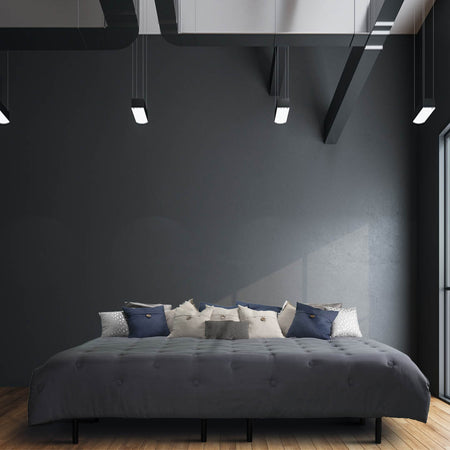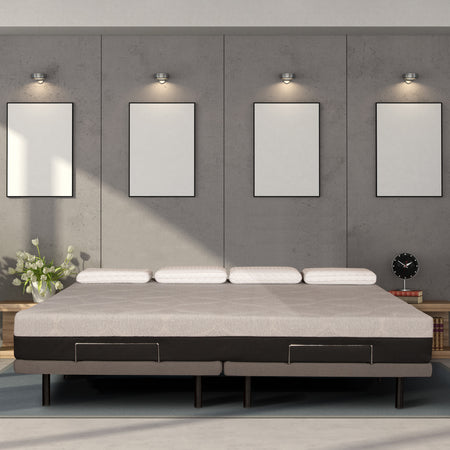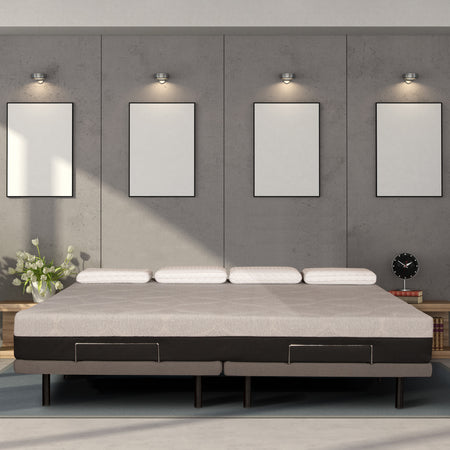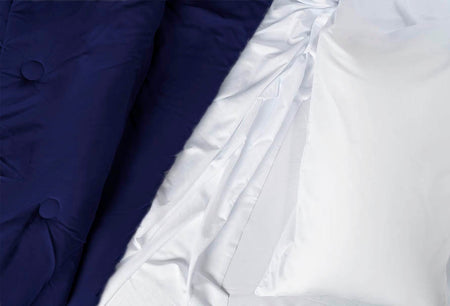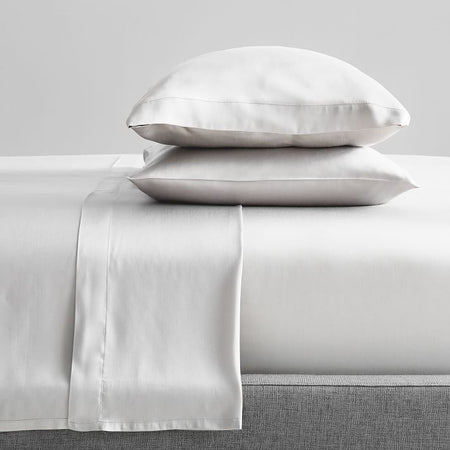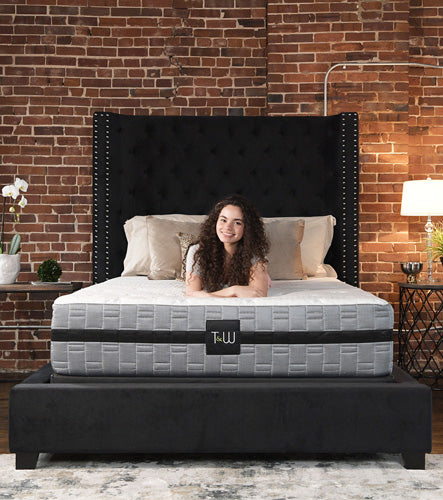If you’ve been waking up sore or restless, there’s a good chance your mattress is part of the problem. Most people buy a bed based on how it feels in the showroom or what an ad promises, but the real secret to good sleep lies underneath the surface, in the layers. Understanding what’s inside your mattress helps you find the right mix of comfort and support without overspending on features you don’t need.
Let’s go layer by layer to see what really makes a mattress comfortable, supportive, and durable.
The Basic Anatomy of a Mattress
Every modern mattress is built in layers, each with a specific job to do. From top to bottom, these layers usually include:
-
The cover: The fabric that wraps the entire mattress, often made with breathable materials like organic cotton or natural fibers such as bamboo or wool.
-
Comfort layers: The softer top sections that you feel most. They determine how plush or firm a mattress feels.
-
Transition layer: A medium-density foam or latex layer that keeps you from sinking too deeply into the mattress.
-
Support core: The firm base layer that gives the mattress structure and prevents sagging over time.

Comfort Layers
When you lie down on a mattress, the first few inches you feel are the comfort layers. These materials contour to your body, ease pressure on your shoulders and hips, and provide that first impression of softness or firmness.
Most comfort layers are made from memory foam, polyurethane foam, natural latex, or fiber fills.
-
Memory foam: This material molds to your body shape as it warms up. It’s known for excellent pressure relief, making it great for side sleepers who need cushioning at the shoulders and hips. Memory foam also offers strong motion isolation, so you won’t feel every movement from a partner. The downside is that some memory foam can trap heat unless it’s infused with cooling gel or copper.
-
Polyurethane foam: Often shortened to “polyfoam,” this is a versatile material found in many memory foam mattresses. It comes in different densities. Softer polyfoams feel springy and budget-friendly, while high-density foam versions are used for extra support and durability. Polyfoam doesn’t hug as much as memory foam, but it tends to feel lighter and cooler.
-
Natural latex: Latex is made from rubber tree sap, and it feels very different from foam. It has a buoyant, slightly bouncy quality that keeps you lifted instead of sinking in. Natural latex is also one of the most eco-friendly mattress materials available. It resists dust mites, stays cool, and lasts for years without sagging.
-
Natural fibers: Some mattresses use wool, silk, or cotton batting as comfort materials. These durable mattress materials offer breathability and softness while maintaining a natural and chemical-free composition.
If your mattress has a pillow top, that’s just an extra layer of padding sewn onto the cover. Pillow tops are often filled with foam, latex, or fiber to give the mattress a plush, cloud-like surface.
Transition Layers
Underneath the comfort layers is the transition layer, a zone that eases your body from soft comfort to firm support.
This layer is usually made from medium-firm foam or latex. It’s designed to prevent you from sinking too far and hitting the firm base beneath. Transition layers are essential for combination sleepers who move around at night. They allow gentle contouring without letting your hips or shoulders drop out of alignment.
A well-designed transition layer adds both balance and durability. It’s what gives a mattress a “supported but soft” feeling, instead of making you feel like you’re stuck in quicksand.
The Support Core
If the top layers make a mattress comfortable, the support core is what keeps it healthy and long-lasting.
So, what is a support core?
A support core is the dense bottom section of the mattress that holds your body in alignment, resists sagging, and stabilizes everything above.

Different mattress types use different materials for their support cores:
-
Foam support core: Found in all-foam and many memory foam mattresses, this base is typically made from thick, high-density polyurethane foam. It provides structure and durability, helping the mattress keep its shape over time.
-
Coil support core: Used in hybrid mattresses and traditional innersprings, this core consists of metal coils that provide bounce and airflow. Pocketed coils (each wrapped in fabric) improve motion isolation and give better contouring support than older open-coil systems.
-
Latex support core: Latex mattresses often use firmer layers of natural latex for the base. Latex is incredibly resilient, offering long-lasting support that retains its shape well.
The support core has the biggest influence on mattress firmness. A thicker, denser core equals a firmer mattress, while a slightly softer base adds a little bit more give.
Cooling and Breathability
If you often wake up sweaty, you’ll want to pay attention to how a mattress handles temperature. Certain layers are designed specifically for cooling.
Memory foam mattresses can trap heat, but many now include cooling features like gel infusions, perforated designs, or phase-change materials that absorb and release body warmth. Hybrid mattresses are naturally cooler because their coil cores allow air to flow through them. Latex mattresses also stay cooler, as natural latex doesn’t retain heat like synthetic foam.
Covers made from organic cotton, bamboo, or Tencel™ help wick away moisture and keep the surface breathable. Eco-friendly mattress materials like wool or natural latex add another layer of temperature regulation while resisting bacteria and dust mites.
Matching Layers to Sleep Needs
The right combination of layers depends on how you sleep and what you value most in a mattress.
For Side Sleepers
Look for softer comfort layers made with memory foam or natural latex that allow your shoulders and hips to sink in slightly. Contouring provides proper pressure relief and helps maintain spinal alignment.
For Back Sleepers
A balanced design works best, with a medium firmness level that keeps your spine supported without feeling too rigid. A hybrid mattress with a foam comfort layer and coil support core is a great fit for many back sleepers.
For Stomach Sleepers
Choose a mattress with thinner comfort layers and a strong support core to keep your hips from dipping too low. Latex and firm hybrids are good choices here.
For Couples
Prioritize motion isolation. Memory foam mattresses and hybrids with pocketed coils absorb movement better, so you won’t wake each other up at night.
For Hot Sleepers
Focus on mattresses with breathable natural fibers, cooling gel foams, or open-coil systems. Latex and hybrid mattresses are excellent at maintaining airflow.
For People with Back Pain
The best mattress for back pain should have a supportive support core and even surface. Look for a mattress that provides both cushioning and structure, typically a medium-firm hybrid or high-density foam design. The goal is to maintain a neutral spine position throughout the night.

Price and Value
Once you understand how layers work, it becomes easier to see where your money is going.
-
Foam layers: Softer foams add comfort, but the denser the foam, the more expensive (and durable) it is. High-density foam bases last longer and prevent sagging.
-
Coils: Coil systems add cost but improve airflow, responsiveness, and edge support.
-
Natural latex and fibers: These are premium materials. They’re more expensive but bring long-lasting comfort, excellent breathability, and natural resistance to allergens.
-
Cooling and specialty layers: Gel-infused foams, copper infusions, and special textiles can raise the price of your new mattress.
If you’re shopping on a budget, prioritize a supportive support core and one or two quality comfort layers. Skip unnecessary add-ons like “smart cooling covers” if you don’t sleep hot. Many mattress companies offer models that use the same base materials as their luxury lines but at a fraction of the cost.
Here’s a rough idea of what you can expect by price range:
-
Under $1,000: Simple all-foam or innerspring mattresses with basic polyurethane foam and limited cooling tech.
-
$1,000–$2,000: Well-balanced hybrid mattresses with thick comfort layers, quality coils, and durable bases.
-
Above $2,000: Premium natural latex, organic covers, zoned support layers, and longer warranties.
Remember, a higher price doesn’t always mean better sleep. It’s the combination of layers and how they suit your body that matters.
Durability and Maintenance
A mattress’s lifespan depends on the materials inside. Durable mattress materials like high-density foam, natural latex, and steel coils can last up to a decade or more with proper care. Lower-density foams or cheaper fiber padding tend to compress faster.
To get the most from your mattress:
-
Rotate it every few months to distribute wear evenly.
-
Use a breathable protector to keep out sweat and dust mites.
-
Keep the base or foundation sturdy to prevent sagging.
Latex and hybrid beds generally retain their shape the longest, while inexpensive all-foam beds may require replacement sooner.
Eco-Friendly and Natural Options
If sustainability matters to you, look for mattresses made with eco-friendly materials, such as natural latex, organic cotton, bamboo, and wool. These materials are renewable, biodegradable, and naturally resistant to mold and dust mites.
Many mattress companies now offer certified organic models, which means the materials are sourced responsibly and processed without harsh chemicals. They tend to be more expensive but can last much longer and provide a cleaner sleep environment.
How Understanding Layers Helps You Sleep Better
When you know what each layer does, you can shop confidently and avoid paying for flashy features that don’t improve your comfort.
If you love a soft, enveloping feel and want the best pressure relief, focus on a mattress with thick comfort layers of memory foam or latex. If you prefer more bounce and breathability, choose a hybrid mattress with coils for airflow. If you want something long-lasting and sustainable, go for natural latex with organic cotton on top.
Every layer has a purpose, comfort, support, temperature control, or durability. When those elements are balanced for your sleep style, you get better rest, fewer aches, and a mattress that feels great for years.


